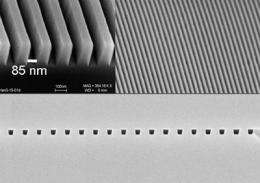Sequencing method to lower human DNA mapping costs

(PhysOrg.com) -- An innovation by Princeton researchers may lower the cost of mapping human DNA to $100 and help usher in the era of personalized medicine.
The technology, which has been named one of the top 10 emerging technologies for 2009 by Technology Review Magazine, uses a series of ever-narrowing channels to stretch out strands of DNA, so that the molecule can be sequenced and key genes indentified. The method was licensed by a Philadelphia-based startup, BioNanomatrix, through Princeton's Office of Technology Licensing.
"If the company succeeds, a physician could biopsy a cancer patient's tumor, sequence all its DNAs, and use that information to determine a prognosis and prescribe treatment -- all for less than the cost of a chest x-ray," Technology Review said of the technology. "If the ailment is lung cancer, for instance, the doctor could determine the particular genetic changes in the tumor cells and order the chemotherapy best suited to that variant."
The method for stretching DNA with the use of nano-scale channels was developed in the labs of two Princeton professors, Robert Austin, from the Department of Physics, and Stephen Chou, from the Department of Electrical Engineering. BioNanomatrix, which is based in Philadelphia, was started in 2003 by Han Cao, a biologist from Chou's lab.
Austin began exploring ways to use channels to stretch DNA molecules in the mid-1990s and teamed up with Chou, who began working on nanofabrication technology in 1982, to develop cheaper and faster ways to produce the channeled chips through which the DNA is passed.
DNA normally bundles itself into a tight ball, a form that's impossible to analyze, so it must be unraveled to read its sequence of nucleotides, the molecules that comprise the structural units of genetic code.
The current method for sequencing a person's genome requires chopping each DNA strand into millions of shorter segments, duplicating each segment million times, sorting them by size and piecing the original sequence back together - a time-consuming and costly process.
In contrast, the concept developed at Princeton only requires one strand of DNA and allows it to be analyzed directly without duplication or sorting, which drastically speeds the process and lowers the cost.
Electrical current is used to draw the molecules through chips, which are perforated by thousands of branching channels that become increasingly narrow until they are only 100 nanometers wide or less.
"The DNA cannot bunch up; it has to straighten out to fit through the channel," said Chou. "This is a completely different technology from conventional methods. The approach we are pursuing is to look at a single strand of DNA in real time."
Austin's group initially used lasers to bore the channels in their chips, but the channels were too wide to stretch DNA straight and drilling each chip by laser took far too long to be economical. Chou's expertise in building nano-scale structures produced a solution.
Chou developed a method for producing narrower channels and applied a technique he developed, called "nanoimprint," to mass produce the DNA chips.
Instead of cutting every DNA chip with a laser, nanoimprint allowed mass production of many DNA chips in a way similar to a printing press. The nanoimprint technique, which has broad applications in a number of areas of science and engineering, was included in Technology Review's 2003 list of emerging technologies.
Though the DNA chips hold potential for working with longer lengths of DNA, the question still remains of how to read the genetic code as the molecules pass through the channels.
Chou said there are a number of ways to approach the problem, from using current techniques of labeling genes with fluorescent markers to scanning the molecules with a tiny electronic sensor and feeding a person's genetic code directly into a computer - something he is currently experimenting with.
"Ours is a pure electrical engineering method," he said. "But theoretically there are several ways to read DNA. We want to find the fastest and cheapest method."
Provided by Princeton University
















